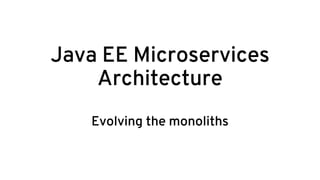
Java EE microservices architecture - evolving the monolith
- 1. Java EE Microservices Architecture Evolving the monoliths
- 2. @myfear blog.eisele.net Red Hat Developer Advocate
- 3. monolith / ˈmɒn(ə)lɪθ/ noun noun: monolith; plural noun: monoliths
- 5. The Curse Of The Monolith We know how to operate them • We know how to develop • We know how to deploy • We know how to scale but there is a price to pay • Large code-bases • Hard to understand and modify • Complex configuration
- 8. The Curse Of SOA Increased everything • Interoperability • Federation • Business and technology alignment but there is a price to pay • Centralized infrastructures • Restricted communication protocols • Vendor driven movement
- 11. What Are Microservices? SOA for DevOps • Single, self-contained, autonomous • Easy(er) to understand individually • Scalability • Testing independently • Individually deployed, has own lifecycle • Single service going down should not impact other services • Right technology stack for the problem (language, databases, etc) • Fail fast • Faster innovation, iteration We want flexible systems and organizations that can adapt to their complex environments, make changes without rigid dependencies and coordination, can learn, experiment, and exhibit emergent behavior. „
- 12. Why now? Why me?
- 14. Enterprise Goals and Objectives Resistant to Change and Economically Efficient Developers Left Alone Technology-Centric Versus Business-Centric
- 15. Single Vendor Platform decisions increasingly unattractive OpenSource moves quickly into this direction Platform as a Service offerings mature Increasing need for business value from software Quicker turnaround cycles for changes required
- 16. We need to build systems for flexibility and resiliency, not just efficiency and robustness.
- 17. And we need to start building them today with what we have.
- 18. From monolith to microservice architecture ?
- 19. Technology alone won’t solve your problem.
- 20. Software Design Outer Architecture Methodology and Organization Distributed Systems Platform As A Service
- 21. Organisation • Autonomous, self-directed teams • Transparency • Small (2-pizza rule) • Purpose, Trust, Empathy driven • Feedback • Experimentation • Respond quickly to change • Own services, delivery, operations • Build it, you own it
- 22. Model culture after open source organizations: meritocracy, shared consciousness, transparency, network, platforms. (Christian Posta, Red Hat) „
- 23. DEV Continuously deliver software Focus on adding value, not maintenance Deliver features faster OPS Minimize manual, repetitive work Stabilize operating environments Encounter issues of reduced complexity Resolve problems quicker
- 25. Software Design Architecture Principles • Single Responsible Principle • Service Oriented Architecture • Encapsulation • Separation of Concern • Loose Coupling • Hexagonal Architecture Design Patterns • Domain-driven Design • Bounded Contexts • Event Sourcing • CQRS • Eventual Consistency • Context Maps
- 26. Design Constraints • Availability • Scalability • Performance • Usability • Flexibility
- 27. Best Practices • Design for Automation • Designed for failure • Service load balancing and automatic scaling • Design for Data Separation • Design for Integrity • Design for Performance
- 28. Strategies For Decomposing Verb or Use Case e.g. Checkout UI Noun e.g. Catalog product service Single Responsible Principle e.g. Unix utilities
- 29. Distributed Systems • The network is unreliable • Design time coupling • Unintended, run-time coupling • Components will fail • Design for resilience, not just robustness
- 30. Control Dependencies • What components depend on the others • Which teams need to engage to make a change • What services need to be changed if one changes • Coordination, contention, synchronization, blocking • Hidden dependencies
- 31. Platform as a Service • Docker, Kubernetes • Developer focused workflow • Source 2 Image builds • Build as first-class citizen • Deployments as first-class citizen • Software Defined Networking (SDN) • Docker native format/packaging • Run docker images • CLI/Web based tooling
- 32. Outer Architecture Load Balancer ServiceAA DBClient Cache APIGateway Security Service Registry Operational Capabilities (Scaling, SLA, Monitoring, Logging, Deployment) Developer Enablement (Documentation, Discovery, Debugging)
- 33. Why now? Why me?
- 34. Java EE 7 Features
- 36. Load Balancer App ServiceSDApp ServiceSD Java EE .ear .war .war .jar .jar .jar .jar DBClient App ServiceSD App ServiceSD ServiceAA .war .jar .jar DBCache GLUE
- 37. Load Balancer App ServiceSDApp ServiceSD Java EE .ear .war .war .jar .jar .jar .jar DB Client App ServiceSD App ServiceSD ServiceAA .war .jar .jar DBCache /service /order Read-only Access!
- 39. Let’s look at some patterns
- 45. Respect The Challenge • No silver bullet; distributed systems are *hard* • Dependency hell, custom shared libraries • Fragmented and inconsistent management • Team communication challenges • Health checking, monitoring, liveness • Over architecting, performance concerns, things spiraling out of control fast
- 46. http://martinfowler.com/bliki/MicroservicePremium.html The fulcrum of whether or not to use microservices is the complexity of the system you're contemplating. (M.Fowler) “
- 47. Lessons Learned Today • Correct functional decomposition is crucial for microservices: • pretty hard to get right from the start • a modular system can evolve to microservices • balance the needs with the costs • work on it evolutionary • Java EE can be a platform for microservices • You need a lot more than just technology
- 48. Fit all the pieces together
- 49. http://bit.ly/ModernJavaEE • Understand the challenges of starting a greenfield development vs tearing apart an existing brownfield application into services • Examine your business domain to see if microservices would be a good fit • Explore best practices for automation, high availability, data separation, and performance • Align your development teams around business capabilities and responsibilities • Inspect design patterns such as aggregator, proxy, pipeline, or shared resources to model service interactions
